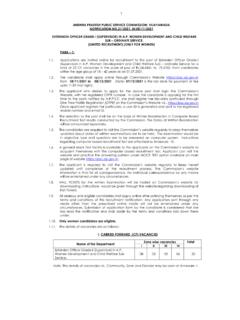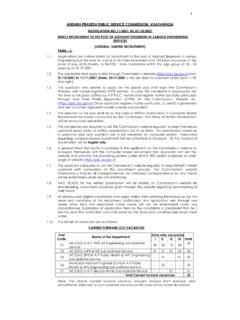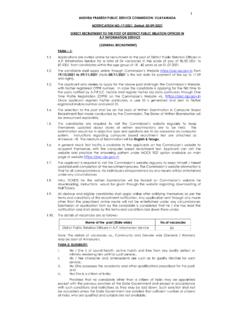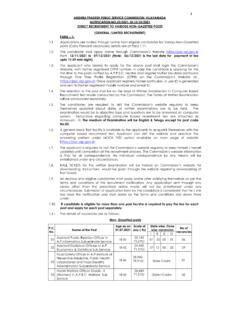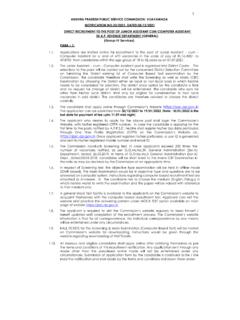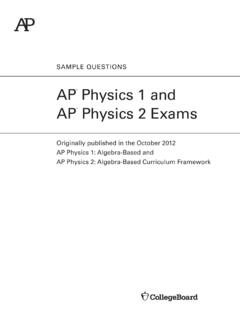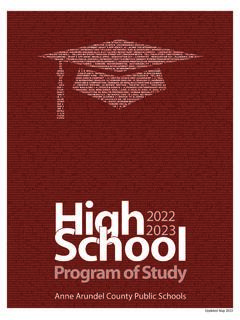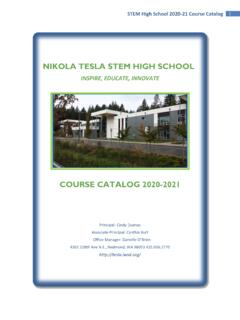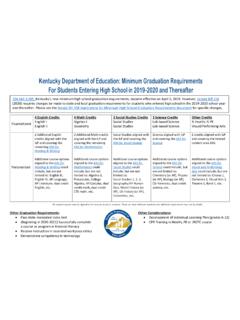Transcription of ANDHRA PRADESH PUBLIC SERVICE …
1 1 ANDHRA PRADESH PUBLIC SERVICE COMMISSION::VIJAYAWADA SCHEME AND SYLLABUS FOR MAIN EXAMINATION TO THE POST OF INDUSTRIAL PROMOTION OFFICER IN INDUSTRIAL SUBORDINATE SERVICE SCHEME FOR WRITTEN ( OBJECTIVE TYPE ) EXAMINATION PAPER Subject Number of Questions Duration in Minutes Maximum Marks PAPER -I General Studies & Mental ability (Degree standard) 150 150 150 PAPER -II Applied Science, Engineering and Management. (Diploma Standard) 150 150 150 Total 300 : NEGATIVE MARKS: As per Ms. Finance (HR-I, Plg & Policy) Dept., , for each wrong answer will be penalized with 1/3rd of the marks prescribed for the question. SYLLABUS PAPER-I 150 Marks GENERAL STUDIES AND MENTAL ABILITY 1.
2 Events of national and international importance. 2. Current affairs- international, national and regional. 3. General Science and it applications to the day to day life Contemporary developments in Science & Technology and information Technology. 4. Social- economic and political history of modern India with emphasis on ANDHRA PRADESH . 5. Indian polity and governance: constitutional issues, PUBLIC policy, reforms and e-governance initiatives with specific reference to ANDHRA PRADESH . 6. Economic development in India since independence with emphasis on ANDHRA PRADESH . 7. Physical geography of Indian sub-continent and ANDHRA PRADESH . 8. Disaster management: vulnerability profile, prevention and mitigation strategies, Application of Remote Sensing and GIS in the assessment of Disaster.
3 9. Sustainable Development and Environmental Protection. 10. Logical reasoning, analytical ability and data interpretation. 2 11. Data Analysis: a) Tabulation of data. b) Visual representation of data. c) Basic data analysis (Summary Statistics such as mean, median, mode, Variance and coefficient of variation) and Interpretation. 12. Bifurcation of ANDHRA PRADESH and its Administrative, Economic, Social, Cultural, Political, and Legal implications/problems. PAPER II APPLIED SCIENCE, ENGINEERING AND MANAGEMENT (DIPLOMA STANDARD) ( 150 Marks) 1. MATHEMATICS 1. ARITHMETIC: a) Number System-Natural numbers, Integers, b) Rational and Real numbers, c) Fundamental operations, addition, subtraction, multiplication, division, Square roots, Decimal fractions.
4 D) Unitary method-time and distance, time and work, percentages, applications to simple and compound interest, profit and loss, ratio and proportion, variation. e) Elementary Number Theory Division algorithm. Prime and composite numbers. Tests of divisibility by 2, 3,4,5,9 and 11. f) Multiples and factors. Factorization theorem. and Euclidean algorithm. Logarithms to base 10, laws of logarithms, use of logarithmic tables. 2. ALGEBRA: a) Basic Operations, simple factors, Remainder Theorem, , b) Theory of polynomials, solutions of quadratic equations, relation between its roots and coefficients (Only real roots to be considered). Simultaneous linear equations in two unknowns Analytical and Graphical solutions.
5 Simultaneous linear inequations in two variables and their solutions. c) Practical problems leading to two simultaneous linear equations or inequations in two variables or quadratic equations in one variable and their solutions. d) Set language and set notation, rational expressions and conditional identities, laws of indices. 3. TRIGONOMETRY: Sine x, Cosine x, Tangent x when Oo = x = 90o values of sin x, cos x and tan x, for x= Oo, 30o, 45o, 60o and trigonometric identities. Use of trigonometric tables. Simple cases of heights and distances. 3 4. GEOMETRY: i) Lines and angles, Plane and plane figures, ii) Theorems on a) Properties of angles at a point, b) Parallel lines, c) Sides and angles of a triangle, d) Congruency of triangles, e) Similar triangles, f) Concurrence of medians and altitudes, g) Properties of angles, sides and diagonals of a parallelogram, rectangle and square, h) Circles and its properties including tangents and normals, i) Loci.
6 5. MENSURATION: a) Areas of squares, rectangles, parallelograms, triangle and circle. b) Areas of figures which can be split up into the figures (Field Book), c) Surface area and volume of cuboids, lateral surface and volume of right circular cones and cylinders, surface area and volume of spheres. 6. STATISTICS: a) Collection and tabulation of statistical data, b) Graphical representation frequency polygons, histograms, bar charts, pie charts etc. c) Measures of central tendency. 1. Units and Dimensions: Introduction, Physical quantity, Fundamental and Derived quantities, Fundamental and Derived units, SI units, Multiples and Sub multiples, Rules for writing units, Advantages of SI units. Dimensions and Dimensional formulae, Dimensional constants and Dimensionless quantities, Principle of homogeneity, Advantages and limitations of dimensional analysis, Errors in measurement, Absolute error, relative error, percentage error, significant figures, Problems.
7 2. Elements of Vectors: Scalars and Vectors, Types of vectors (Proper Vector, Null Vector, Unit Vector, Equal, Negative Vector, Like Vectors, Co-Initial Vectors, Co-planar Vectors and Position Vector).Addition of vectors, Representation of vectors, Resolution of vectors, Parallelogram, Triangle and Polygon laws of vectors, Subtraction of vectors, Dot and Cross products of vectors-Problems. 3. Dynamics Introduction-Concept of acceleration due to gravity-Equations of motion for a freely falling body and for a body thrown up vertically- Projectiles- Horizontal and Oblique projections- Expressions for maximum height, time of flight, range-Define force, momentum, angular displacement, angular velocity, angular acceleration, angular momentum, moment of inertia, torque problems.
8 4 4. Friction: Introduction to friction- Causes- Types of friction- Laws of friction- Angle of repose-Angle of friction- rough inclined plane- Advantages and disadvantages of friction-Methods of reducing friction Problems. 5. Work, Power and Energy: Work, Power and Energy- Definitions and explanation- potential energy- kinetic energy- Derivations of Potential and Kinetic and Momentum relation - Work-Energy theorem- Law of Conservation of energy- Problems. 6. Simple Harmonic Motion: Introduction- Conditions of SHM- Definition- Examples- Expressions for displacement, velocity, acceleration, Time period, frequency and phase in SHM- Time period of a simple pendulum- Laws of simple pendulum-seconds pendulum-Problems. 7. Heat and Thermodynamics: Expansion of Gases, Boyle s law, absolute scale of temperature- Charles laws- Ideal gas equation- Universal gas constant- Differences between gas constant(r) and universal gas constant(R),Isothermal and adiabatic processes, Laws of thermodynamics, Specific heats - molar specific heats of a gas -Different modes of transmission of heat ,laws of thermal conductivity, Coefficient of thermal conductivity-Problems.
9 8. Sound: Sound- Nature of sound- Types of wave motion -musical sound and noise- Noise pollution Causes &effects- Methods of reducing noise pollution- Beats- Doppler effect- Echo- Reverberation-Reverberation time-Sabine s formula-Conditions of good auditorium- Problems. 9. Properties of matter Definition of Elasticity Definition of stress and strain -the u n its and d i me n s i o n a l f or mu la e for s t r es s and s t r a in - The Hooke s law-Definitions of Modulus of elasticity, Young s modulus(Y), Bulk modulus(K), Rigidity modulus ( n), Poisson s ratio (), relation between Y, K, n and (equations only no derivation). Definition of surface tension- Explanation of Surface tension with reference to molecular theory - Definition of angle of contact -Definition of capillarity -The formula for surface tension based on capillarity - Explanation of concept of Viscosity - Examples for surface tension and Viscosity - Newton s formula for viscous force- Definition of co-efficient of viscosity- The effect of temperature on viscosity of liquids and gases - Poiseuille s equation for Co-efficient of viscosity- The related numerical problems.
10 10. Electricity & Magnetism: Ohm s law and explanation, Specific resistance, Kirchhoff s laws, Wheatstone s bridge, Meter bridge, Coulomb s inverse square law, magnetic field, magnetic lines of force, magnetic induction field strength- magnetic induction field strength at a point on the axial line - magnetic induction field strength at a point on the equatorial line problems. 5 11. Modern Physics; Photoelectric effect Einstein s photoelectric equation-laws of photoelectric effect- photoelectric cell Applications of photo electric effect- Total internal reflection- fiber optics- -principle and working of an optical fiber-types of optical fibers - Applications of optical fibers- superconductivity applications-Nanotechnology definition, nanomaterials, applications.


